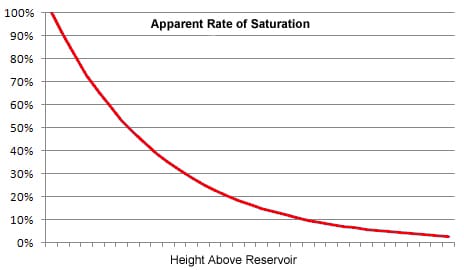Folks who are new to Semi-Hydroponics often become concerned when the top of the medium appears to be dry, while the rest of the medium is nice and moist. Let me assure you that the appearance of a “dry line” is perfectly normal. There will always be something of a gradient in moisture from bottom to top, unless you’re growing in 100% relative humidity (RH), which is not healthy for your plants.
We are dealing with two dynamic and competing processes: evaporation, trying to remove water from the system, and capillary action, trying to move water up from the reservoir to replenish what is lost.
The evaporation rate is controlled primarily by ambient temperature and relative humidity. We can assume, for the sake of this discussion, that the temperature is constant throughout the pot. Based upon that alone, the evaporation rate from each LECA pellet should be identical – but it’s not. The pellets down within the “body” of the pot are surrounded by other pellets, and that keeps the localized relative humidity very high – probably close to 100% right after watering. Those at the top surface are not fully surrounded, so have the air – at a lower RH – into which water can evaporate more freely. The evaporation rate at the top, therefore, is significantly greater than elsewhere in the pot.
The wicking rate of a medium is “fixed”, but is affected by the specific characteristics of the pellets:
• Absorption capacity
• Absorption/release efficiency
• Porosity size, shape, density, and distribution
• Surface texture
• Particle size, shape, and uniformity
It may vary from brand-to-brand, but for any given product, it is a constant – i.e., it does not change with the conditions.
That fixed wicking rate does not necessarily mean that the transfer of water from bottom-to-top is constant, however. Consider that a pellet – like a sponge – wants to hold onto the liquid it absorbs. In essence, a pellet wants to become 100% full of water, before it will pass on any to an adjacent pellet. Fortunately, they take time to do so and surface tension can be an opposing force (the visible drop of water held between the medium and the pot wall is an indicator of that), so some of the water will be passed on before the pellet is fully saturated.
As a grossly-oversimplified example, let’s say that 90% of the liquid can be passed onto an adjacent pellet while it is continuing to absorb. The pellets right above the reservoir have a vast reservoir of liquid to work with, so rapidly pass some onto the next layer. That next layer, however, is only getting 90% of the water the layer below did, so it will “fill up” more slowly. The next layer above that only gets 90% of its neighbor’s liquid, and that’s equivalent to only 81% of the first layer – slower still. In this simplified, “straight line” example, the rate at which each layer became saturated would vary with the distance above the reservoir, like this:

Eventually, all of the pellets would be saturated, but for those at the top, it might be a long time coming. In reality, partially due to the fact the the pellets are in contact with many others, the rate is fairly quick.
Putting the two together means, therefore, that we are dealing with “fixed” and “variable” components – wicking and evaporation, respectively. Because of that, you may actually see the “dry line” move up and down seasonally, in response to a weather change, or something else that affects the local environment. There are other factors that play a role in this as well – increased air movement and light level (which can heat the top surface) will also accelerate the evaporation rate. You’ll probably also see differences based upon the pots used – a “squat” pot, having a shorter distance from the top of the reservoir to the top of the medium, will stay wetter, higher.
Also keep in mind that the medium looking dry may only mean the outer surface is – there still might be moisture within the pellet itself.